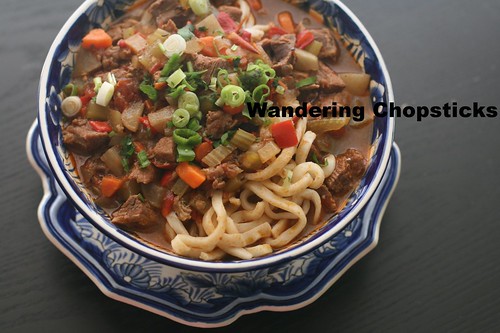
My first encounter with Lagman (Uzbek Lamb Noodle Soup) was at the now defunct Uzbekistan - Los Angeles. At the time, I dismissed it as a basic beef stew with similar Chinese noodles. Seven years later, after having explored other Central Asian cuisines, I hope I've become less cavalier of other cuisines in general, but of Central Asian cuisines in particular.
I try to place new cuisines into what's familiar, and would describe Uzbek and other Central Asian foods as a cross between Chinese Islamic and Middle Eastern cuisines. Which, if you think of the former, is already a confluence of two different cuisines.
If lagman seems familiar, that's because the word is derived from lamian (Chinese hand-pulled noodles). The Uzbek version is thicker, similar to Japanese udon, but much more tender. I stumbled upon a package of Shanghai home-style noodles at the grocery store, which looked so very homemade that I couldn't resist buying it so I could experiment. If you can't find Chinese hand-pulled noodles, then I'd suggest substituting with udon or even fettuccine.
Now, as for the lamb or beef stew portion of the soup, I knew there was an undefinable something that made Uzbek lagman stand apart. A little Googling and I found a lagman recipe from Bois de Jasmin that mentioned kala jeera (Indian black cumin). I debated whether to be lazy and substitute with regular cumin, but hauled myself off to Bhanu Indian Grocery & Cuisine - San Gabriel and luckily found a package in stock. One whiff of the smoky aroma and I knew it was worth the trip. No, regular cumin is not remotely similar to black cumin. I would omit it if you can't find any, but if you can, oh, does it add that something.
I find lamb to be quite gamey, unless it's rack of or thinly sliced for hot pot. So I used a combination of the latter with some venison my dad had shot. Regular beef is perfectly fine to use in this soup as well. The lagman I had at Varzoba Kafejnica - Riga - Latvia was described on the menu as a tomato soup, of which I had plenty from my garden. You can cut the vegetables into a thick julienne or dice them as I have. And lastly, as these are fresh noodles, don't add the noodle to the soup. Rather, boil the noodles separately, and spoon the stew over the soup.
I looked through my photos of the lagman I ate at Varzoba Kafejnica and was struck by the artful plating of the bright blue bowl atop a blue plate. Rummaged through my kitchen cabinets for something similar and I have to say the plating made my Uzbek lagman look so much more tempting, don't you think?
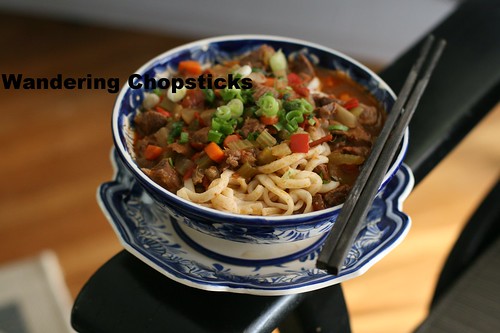
Lagman (Uzbek Lamb Noodle Soup)
For a 5-quart stock pot, about 4 to 6 servings, you'll need:
1 lb lamb or venison or beef, cubed
1 large onion, diced
4 cloves garlic, minced
3 stalks celery, diced
2 large carrots, diced
10 radishes or 1 turnip, diced
1 red bell pepper, diced
1 tsp black cumin seeds
2 tsps salt
1 tsp ground black pepper
1 tsp black cumin seeds
2 star anise pods
4 large tomatoes, diced or a 28-oz can tomatoes
1 lb fresh wheat noodles
For garnish: chopped cilantro, parsley, or dill
Dice 1 lb lamb or venison or beef. In a stock pot on medium-high heat, drizzle a bit of oil and add the meat.
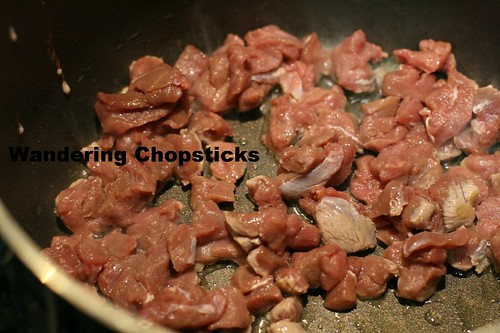
I added some sliced lamb too. While the meat is cooking, chop up an onion and mince 4 cloves of garlic.
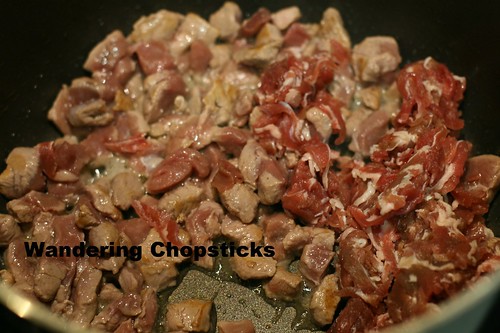
When the meat is browned, add the onion and garlic.

Meanwhile, dice 3 stalks celery, 2 carrots, 10 radishes, and 1 red bell pepper and add them to the pot.

Now comes kala jeera to add smokiness.
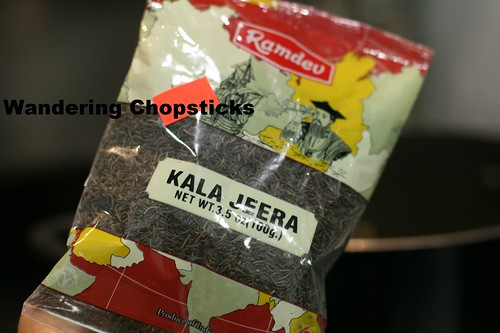
Just 1 tsp is plenty. Or omit if you can't find it.
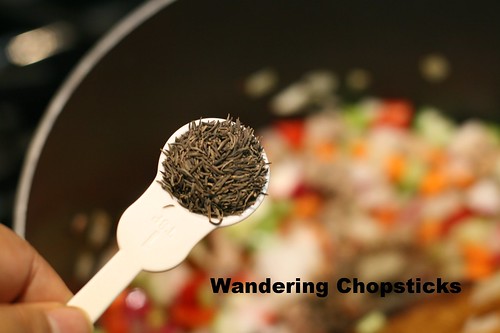
Add 2 tsps salt, 1 tsp ground black pepper, and 2 star anise pods.

Stir to release the fragrance of the spices.

Add 4 large diced tomatoes or a 28-oz can of tomatoes.
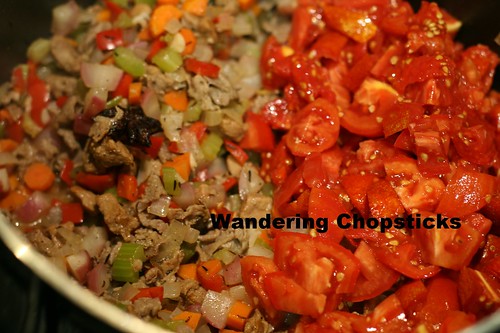
Mix and let the tomatoes soften for a few minutes as they release liquid. Add 2 to 3 quarts of water, until about an inch covers the soup. Then turn the heat down to medium, lightly cover the pot, and let simmer for half an hour to 45 minutes.
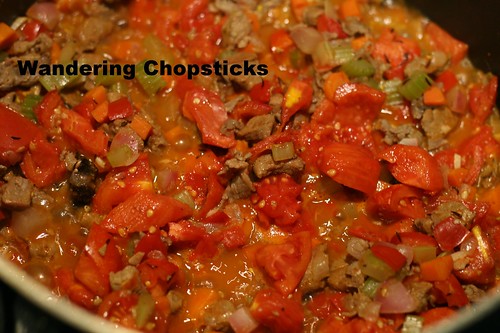
I highly recommend this package of Shanghai home-style noodle if you can find it.

Meanwhile, set a pot of water to boil the noodles.
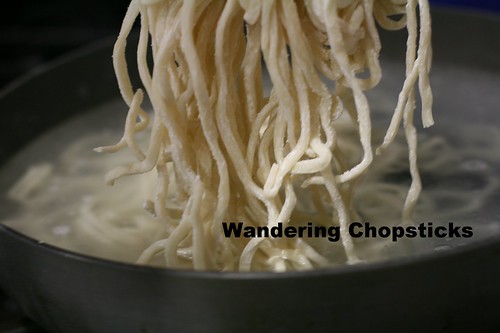
Drain into a colander and set aside until the soup is ready. Just look at those beautiful hand-pulled noodles.

When the soup is ready, place a little bit of the noodles in each bowl and ladle the soup over the noodles. Garnish with chopped scallions, cilantro, parsley, or dill.

The noodles are quite hearty, and this bowl will fill you up faster than you think.
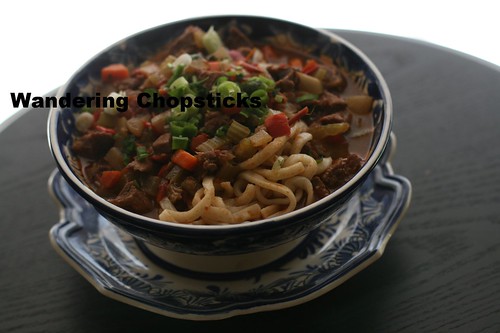
Enjoy!
Other noodle soups you might like:
Bun Mang Ga Tay (Vietnamese Rice Vermicelli Noodle Soup with Bamboo Shoots and Turkey)
Bun Rieu Cua Tom Oc (Vietnamese Crab and Shrimp Rice Vermicelli Noodle Soup with Snails)
Bun Thang (Vietnamese Rice Vermicelli Noodle Soup with Chicken, Egg, and Pork)
Crock Pot Pho Bo (Vietnamese Beef Noodle Soup)
Nabeyaki Udon (Japanese Hot Pot Thick Noodle Soup in a Metal Pot)
Pho Ga (Vietnamese Chicken Noodle Soup)
Shichimenchou (Japanese Turkey Bone) Ramen
Torigara Shoyu (Japanese Soy Sauce Chicken) Ramen
*****
1 year ago today, planting pennywort and harvesting the last figs.
2 years ago today,
3 years ago today, Bun Nem Nuong Cha Gio (Vietnamese Rice Vermicelli Noodles with Grilled Pork Patties and Egg Rolls).
4 years ago today, Dong Nguyen Restaurant - Alhambra.
5 years ago today, Petroglyph Point Trail - Mesa Verde National Park - Colorado.
6 years ago today, an American classic, the BLT (Bacon, Lettuce, and Tomato) Sandwich.
7 years ago today, Sinh To Nha Dam (Vietnamese Aloe Vera Shake).

No comments:
Post a Comment
Thank you for stopping by. I try to respond in a timely manner, but am not always able to do so. If you're awaiting a response, check the post in which the comment is made or click the "Notify me" option.
If you're not a blogger and you'd like to leave a comment, you can do so using your Google/Gmail account.
I welcome questions, discussions, and feedback, but please be mindful that this is my home online. I reserve the right to delete any comment that is anonymous or unknown, rude, promotional, or has a link.
Thank you for reading!